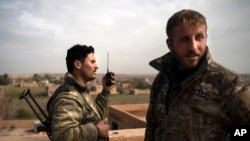U.S. President Donald Trump tweeted late Saturday that the Islamic State’s self-declared caliphate is "ready to fall," but he threatened to allow hundreds of the terror group’s fighters to wreak havoc on their countries of origins if Washington's allies refuse to take them back.
The two tweets, sent by the president from his Mar-a-Lago retreat in Florida, were the Trump’s first comments on the fight against IS since he teased "a lot of great announcements" during an appearance at the White House Friday morning.
"We have a lot of great announcements having to do with Syria and our success with the eradication of the caliphate," Trump said at the time. “That'll be announced over the next 24 hours."
But the president took a much different tone late Saturday, pressuring U.S. allies to do more, while at the same time declaring, “The Caliphate is ready to fall.”
“The United States is asking Britain, France, Germany and other European allies to take back over 800 ISIS fighters that we captured in Syria and put them on trial,” he wrote, using an acronym for the terror group. ”The alternative is not a good one in that we will be forced to release them.”
“The U.S. does not want to watch as these ISIS fighters permeate Europe, which is where they are expected to go,” he added in a second tweet, warning “We are pulling back after 100% Caliphate victory!”
The tweets come as commanders with the U.S.-backed Syrian Democratic Forces said time was quickly running out on the Islamic State’s physical caliphate, reduced to a patch of land encompassing only about 600 to 700 square meters near the eastern Syrian village of Baghuz, and surrounded on all sides.
“In a very short time, we will spread the good tidings to the world of the military end of Daesh,” Jiya Furat, the SDF commander leading the final assault, told reporters during a news conference Saturday, using an Arabic acronym for the group.
Progress slowed
Still, both the SDF and officials with the U.S.-led coalition cautioned efforts to finish off the final IS enclave have been slowed due to a variety of concerns.
“There have been some lapses in the battle as we continue to see hundreds of civilians still attempting to flee,” coalition spokesman, Col. Sean Ryan, told VOA via email Saturday. “Strikes have been reduced to help protect the civilians.”
Weather conditions have also played a role, officials said, as have IS counterattacks.
"Sleeper cells of Daesh [Saturday] morning attacked security forces near Busayra, a town dozens of kilometers away from frontline," Mustafa Bali, the head of the SDF media office, tweeted late Saturday.
The Syria Observatory for Human Rights, a London-based group with monitors on the ground, reported a second IS attack late Saturday in the town of Theban, saying it was repelled only after coalition warplanes were called in.
Those attacks followed an unsuccessful assault Friday by IS fighters on an oil field near Baghuz, which was also eventually pushed back.
The SDF advance has also been slowed by IS use of booby traps and other improvised explosive devices [IEDs], and counterattacks using suicide bombers and cars or motorcycles laden with explosives.
There are concerns, too, about additional IS fighters hiding in what appears to be an extensive system of tunnels and caves.
Size of IS hard to gauge
U.S. officials have said repeatedly that even once the last pocket of IS-held territory is taken, the fight will not be over. Some have warned the terror group still has 20,000 to 30,000 followers, including fighters, spread across Syria and Iraq, including thousands who originated from other countries.
Speaking at the Munich Security Conference in Germany Saturday, U.S. Vice President Mike Pence promised the U.S. would maintain a strong presence in the Middle East and would “track down” any remnants or offshoots of the Islamic State.
U.S. counterterrorism officials estimate more than 45,000 fighters from 110 countries, including almost 8,000 Westerners, have flocked to Syria since the start of the conflict there, the majority of them ultimately aligning themselves with IS.
According to top U.S. military officials, hundreds of them, along with their wives and children, are being held by the SDF.
“It’s actually closer to 1,000 than it is in the hundreds already in detention, with more potentially to come,” Gen. Tony Thomas, the commander of U.S. Special Operations Command, told lawmakers Thursday.
Some SDF officials and observer groups have suggested the actual number could be twice as high, not including hundreds of wives, children and other family members. And it is a number that officials say has been growing in recent weeks as many IS families have fled the intense fighting around Baghuz.
U.S. defense and diplomatic officials have been urging Western countries for months to take back their foreign fighters.
Some countries, like France, have agreed to repatriate some of their citizens, but progress has been slow, as many countries worry about the ability of their legal systems to successfully prosecute crimes committed while in Syria, given that legal evidence may be scarce.
Some in the U.S., like Senate Armed Services Committee Chairman Jim Inhofe, suggest sending the foreign fighters to the U.S. prison at Guantanamo Bay, Cuba.
"That would be something that gets everybody really hysterical, but we've got a great asset over there and we need to be using that asset," Inhofe told reporters this past week.














